Analysis of the Swedish Foreign Service Feminist Policy Action Plan
VerifiedAdded on 2022/08/20
|15
|4331
|19
Report
AI Summary
This report analyzes the Swedish Foreign Service action plan for feminist foreign policy (2015-2018) through the lens of Carol Bacchi's 'What's the Problem Represented to Be?' approach and a poststructuralist perspective. The analysis investigates the policy's problematizations of gender equality, women's rights, and power dynamics, examining the underlying assumptions and silences within the policy's framework. The report also explores how the policy constructs subject formation, particularly concerning women, using a post-colonial lens. It examines the policy's objectives for achieving gender equality, including strengthening women's human rights, addressing gender-based violence, and ensuring equal treatment. The report evaluates the policy's strengths, limitations, and potential alternative approaches to promote gender equality and enhance Sweden's global image.
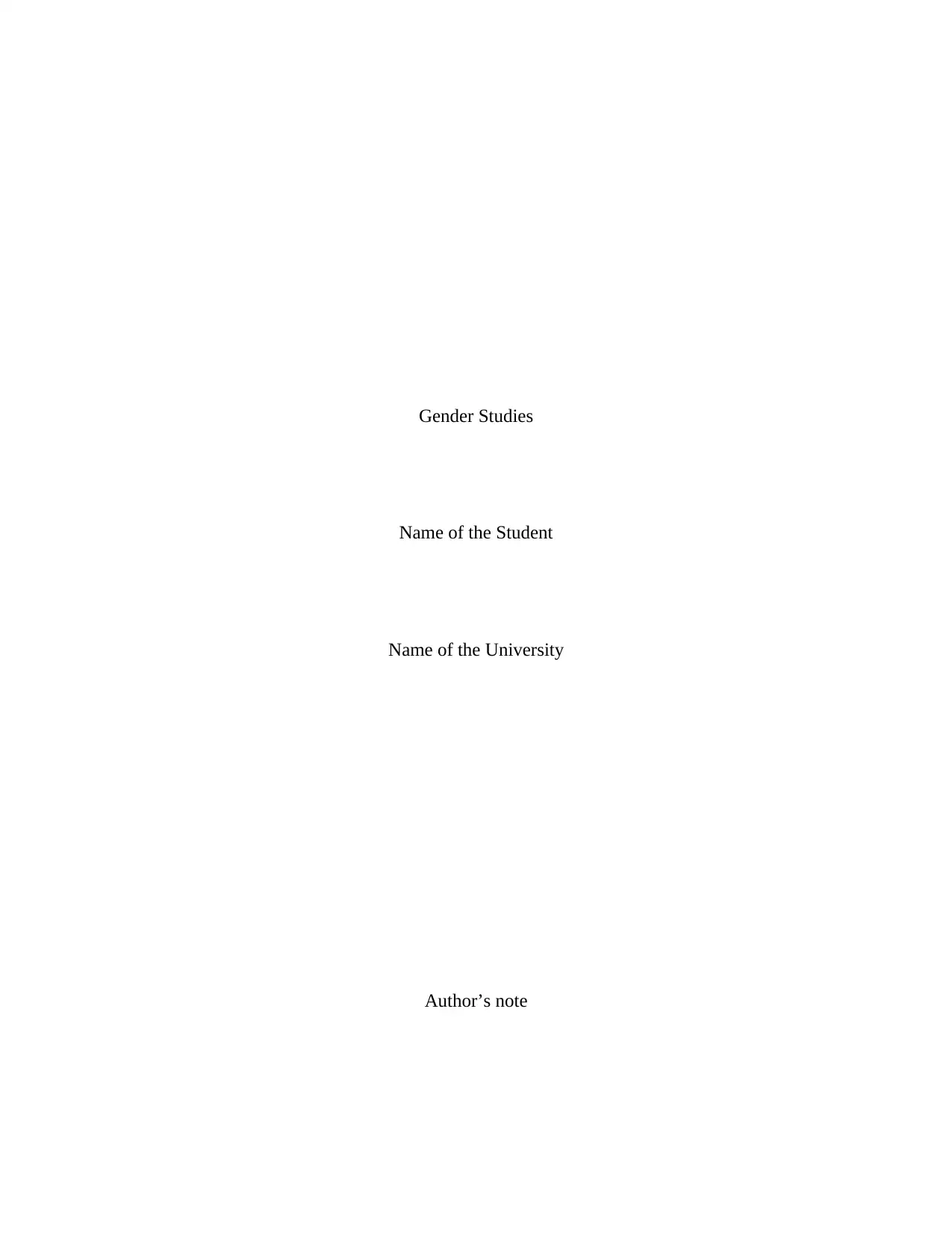
Gender Studies
Name of the Student
Name of the University
Author’s note
Name of the Student
Name of the University
Author’s note
Paraphrase This Document
Need a fresh take? Get an instant paraphrase of this document with our AI Paraphraser
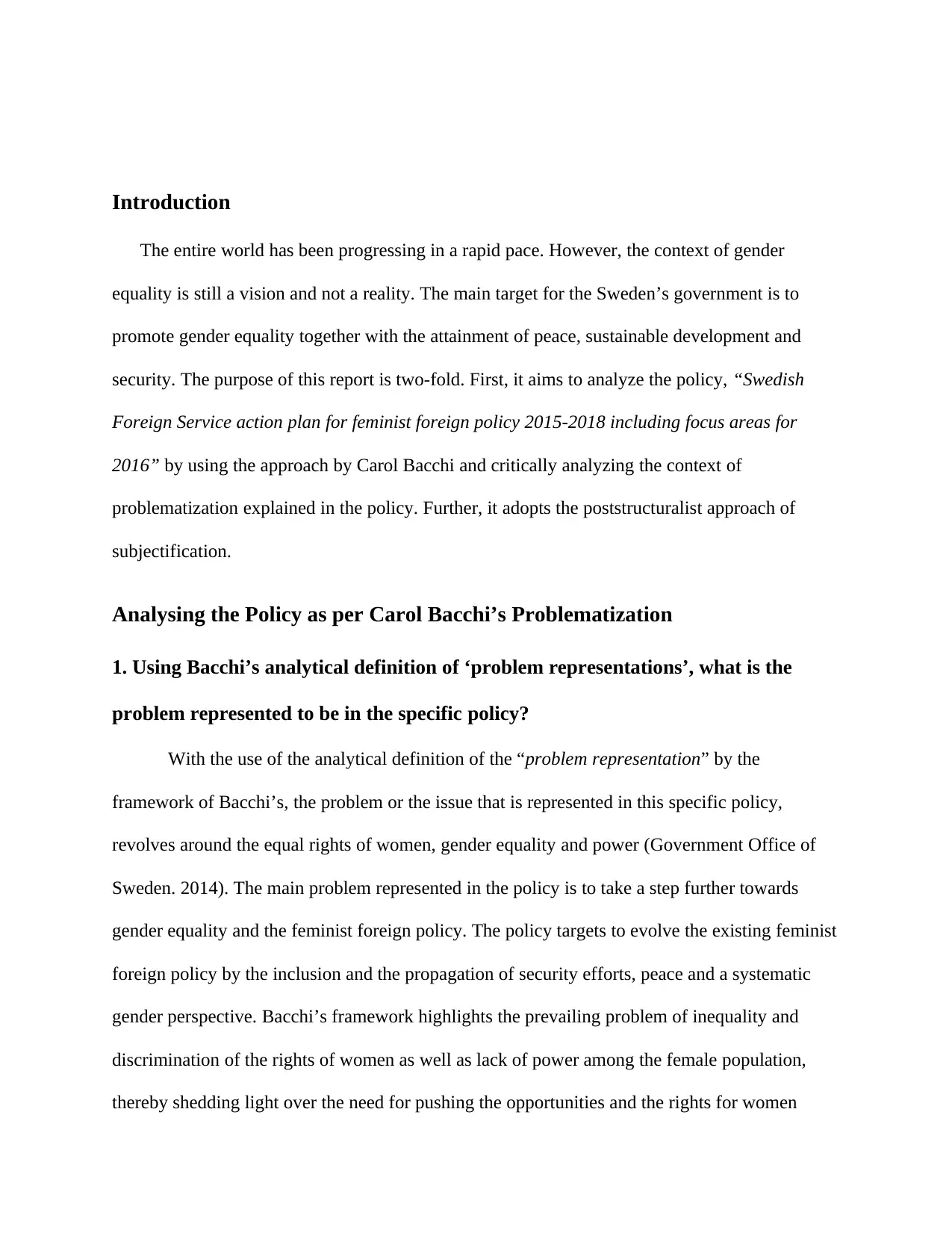
Introduction
The entire world has been progressing in a rapid pace. However, the context of gender
equality is still a vision and not a reality. The main target for the Sweden’s government is to
promote gender equality together with the attainment of peace, sustainable development and
security. The purpose of this report is two-fold. First, it aims to analyze the policy, “Swedish
Foreign Service action plan for feminist foreign policy 2015-2018 including focus areas for
2016” by using the approach by Carol Bacchi and critically analyzing the context of
problematization explained in the policy. Further, it adopts the poststructuralist approach of
subjectification.
Analysing the Policy as per Carol Bacchi’s Problematization
1. Using Bacchi’s analytical definition of ‘problem representations’, what is the
problem represented to be in the specific policy?
With the use of the analytical definition of the “problem representation” by the
framework of Bacchi’s, the problem or the issue that is represented in this specific policy,
revolves around the equal rights of women, gender equality and power (Government Office of
Sweden. 2014). The main problem represented in the policy is to take a step further towards
gender equality and the feminist foreign policy. The policy targets to evolve the existing feminist
foreign policy by the inclusion and the propagation of security efforts, peace and a systematic
gender perspective. Bacchi’s framework highlights the prevailing problem of inequality and
discrimination of the rights of women as well as lack of power among the female population,
thereby shedding light over the need for pushing the opportunities and the rights for women
The entire world has been progressing in a rapid pace. However, the context of gender
equality is still a vision and not a reality. The main target for the Sweden’s government is to
promote gender equality together with the attainment of peace, sustainable development and
security. The purpose of this report is two-fold. First, it aims to analyze the policy, “Swedish
Foreign Service action plan for feminist foreign policy 2015-2018 including focus areas for
2016” by using the approach by Carol Bacchi and critically analyzing the context of
problematization explained in the policy. Further, it adopts the poststructuralist approach of
subjectification.
Analysing the Policy as per Carol Bacchi’s Problematization
1. Using Bacchi’s analytical definition of ‘problem representations’, what is the
problem represented to be in the specific policy?
With the use of the analytical definition of the “problem representation” by the
framework of Bacchi’s, the problem or the issue that is represented in this specific policy,
revolves around the equal rights of women, gender equality and power (Government Office of
Sweden. 2014). The main problem represented in the policy is to take a step further towards
gender equality and the feminist foreign policy. The policy targets to evolve the existing feminist
foreign policy by the inclusion and the propagation of security efforts, peace and a systematic
gender perspective. Bacchi’s framework highlights the prevailing problem of inequality and
discrimination of the rights of women as well as lack of power among the female population,
thereby shedding light over the need for pushing the opportunities and the rights for women
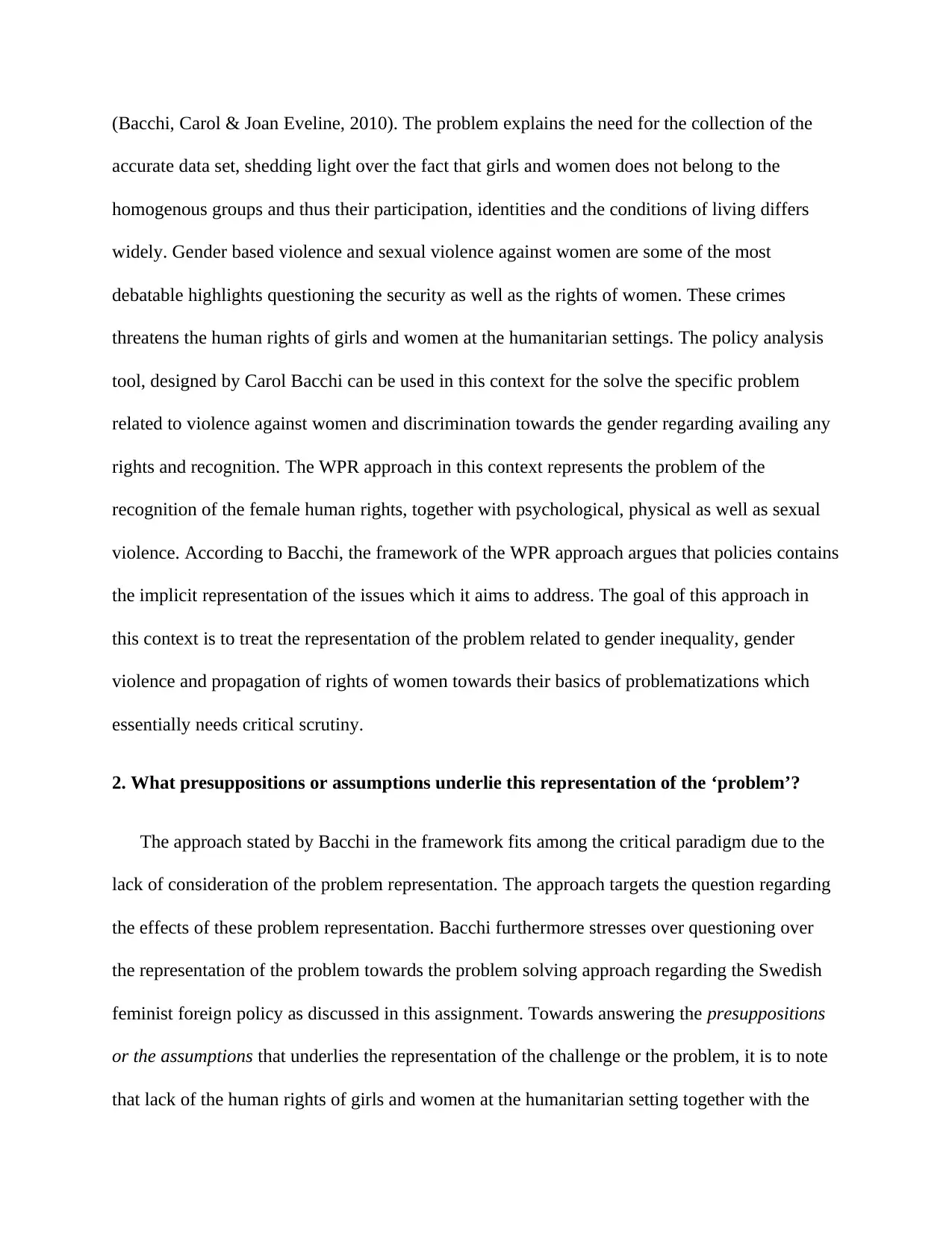
(Bacchi, Carol & Joan Eveline, 2010). The problem explains the need for the collection of the
accurate data set, shedding light over the fact that girls and women does not belong to the
homogenous groups and thus their participation, identities and the conditions of living differs
widely. Gender based violence and sexual violence against women are some of the most
debatable highlights questioning the security as well as the rights of women. These crimes
threatens the human rights of girls and women at the humanitarian settings. The policy analysis
tool, designed by Carol Bacchi can be used in this context for the solve the specific problem
related to violence against women and discrimination towards the gender regarding availing any
rights and recognition. The WPR approach in this context represents the problem of the
recognition of the female human rights, together with psychological, physical as well as sexual
violence. According to Bacchi, the framework of the WPR approach argues that policies contains
the implicit representation of the issues which it aims to address. The goal of this approach in
this context is to treat the representation of the problem related to gender inequality, gender
violence and propagation of rights of women towards their basics of problematizations which
essentially needs critical scrutiny.
2. What presuppositions or assumptions underlie this representation of the ‘problem’?
The approach stated by Bacchi in the framework fits among the critical paradigm due to the
lack of consideration of the problem representation. The approach targets the question regarding
the effects of these problem representation. Bacchi furthermore stresses over questioning over
the representation of the problem towards the problem solving approach regarding the Swedish
feminist foreign policy as discussed in this assignment. Towards answering the presuppositions
or the assumptions that underlies the representation of the challenge or the problem, it is to note
that lack of the human rights of girls and women at the humanitarian setting together with the
accurate data set, shedding light over the fact that girls and women does not belong to the
homogenous groups and thus their participation, identities and the conditions of living differs
widely. Gender based violence and sexual violence against women are some of the most
debatable highlights questioning the security as well as the rights of women. These crimes
threatens the human rights of girls and women at the humanitarian settings. The policy analysis
tool, designed by Carol Bacchi can be used in this context for the solve the specific problem
related to violence against women and discrimination towards the gender regarding availing any
rights and recognition. The WPR approach in this context represents the problem of the
recognition of the female human rights, together with psychological, physical as well as sexual
violence. According to Bacchi, the framework of the WPR approach argues that policies contains
the implicit representation of the issues which it aims to address. The goal of this approach in
this context is to treat the representation of the problem related to gender inequality, gender
violence and propagation of rights of women towards their basics of problematizations which
essentially needs critical scrutiny.
2. What presuppositions or assumptions underlie this representation of the ‘problem’?
The approach stated by Bacchi in the framework fits among the critical paradigm due to the
lack of consideration of the problem representation. The approach targets the question regarding
the effects of these problem representation. Bacchi furthermore stresses over questioning over
the representation of the problem towards the problem solving approach regarding the Swedish
feminist foreign policy as discussed in this assignment. Towards answering the presuppositions
or the assumptions that underlies the representation of the challenge or the problem, it is to note
that lack of the human rights of girls and women at the humanitarian setting together with the
⊘ This is a preview!⊘
Do you want full access?
Subscribe today to unlock all pages.

Trusted by 1+ million students worldwide
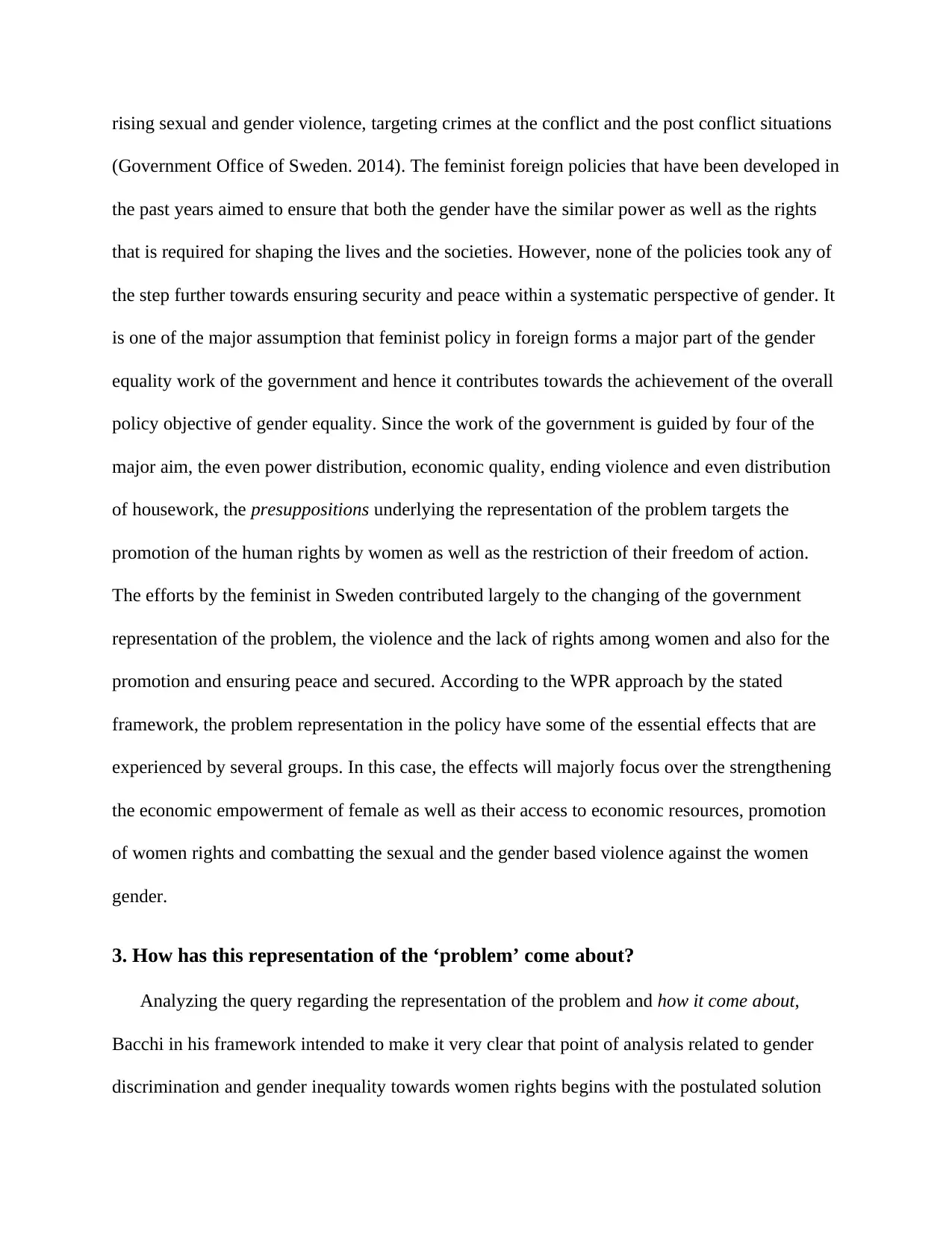
rising sexual and gender violence, targeting crimes at the conflict and the post conflict situations
(Government Office of Sweden. 2014). The feminist foreign policies that have been developed in
the past years aimed to ensure that both the gender have the similar power as well as the rights
that is required for shaping the lives and the societies. However, none of the policies took any of
the step further towards ensuring security and peace within a systematic perspective of gender. It
is one of the major assumption that feminist policy in foreign forms a major part of the gender
equality work of the government and hence it contributes towards the achievement of the overall
policy objective of gender equality. Since the work of the government is guided by four of the
major aim, the even power distribution, economic quality, ending violence and even distribution
of housework, the presuppositions underlying the representation of the problem targets the
promotion of the human rights by women as well as the restriction of their freedom of action.
The efforts by the feminist in Sweden contributed largely to the changing of the government
representation of the problem, the violence and the lack of rights among women and also for the
promotion and ensuring peace and secured. According to the WPR approach by the stated
framework, the problem representation in the policy have some of the essential effects that are
experienced by several groups. In this case, the effects will majorly focus over the strengthening
the economic empowerment of female as well as their access to economic resources, promotion
of women rights and combatting the sexual and the gender based violence against the women
gender.
3. How has this representation of the ‘problem’ come about?
Analyzing the query regarding the representation of the problem and how it come about,
Bacchi in his framework intended to make it very clear that point of analysis related to gender
discrimination and gender inequality towards women rights begins with the postulated solution
(Government Office of Sweden. 2014). The feminist foreign policies that have been developed in
the past years aimed to ensure that both the gender have the similar power as well as the rights
that is required for shaping the lives and the societies. However, none of the policies took any of
the step further towards ensuring security and peace within a systematic perspective of gender. It
is one of the major assumption that feminist policy in foreign forms a major part of the gender
equality work of the government and hence it contributes towards the achievement of the overall
policy objective of gender equality. Since the work of the government is guided by four of the
major aim, the even power distribution, economic quality, ending violence and even distribution
of housework, the presuppositions underlying the representation of the problem targets the
promotion of the human rights by women as well as the restriction of their freedom of action.
The efforts by the feminist in Sweden contributed largely to the changing of the government
representation of the problem, the violence and the lack of rights among women and also for the
promotion and ensuring peace and secured. According to the WPR approach by the stated
framework, the problem representation in the policy have some of the essential effects that are
experienced by several groups. In this case, the effects will majorly focus over the strengthening
the economic empowerment of female as well as their access to economic resources, promotion
of women rights and combatting the sexual and the gender based violence against the women
gender.
3. How has this representation of the ‘problem’ come about?
Analyzing the query regarding the representation of the problem and how it come about,
Bacchi in his framework intended to make it very clear that point of analysis related to gender
discrimination and gender inequality towards women rights begins with the postulated solution
Paraphrase This Document
Need a fresh take? Get an instant paraphrase of this document with our AI Paraphraser
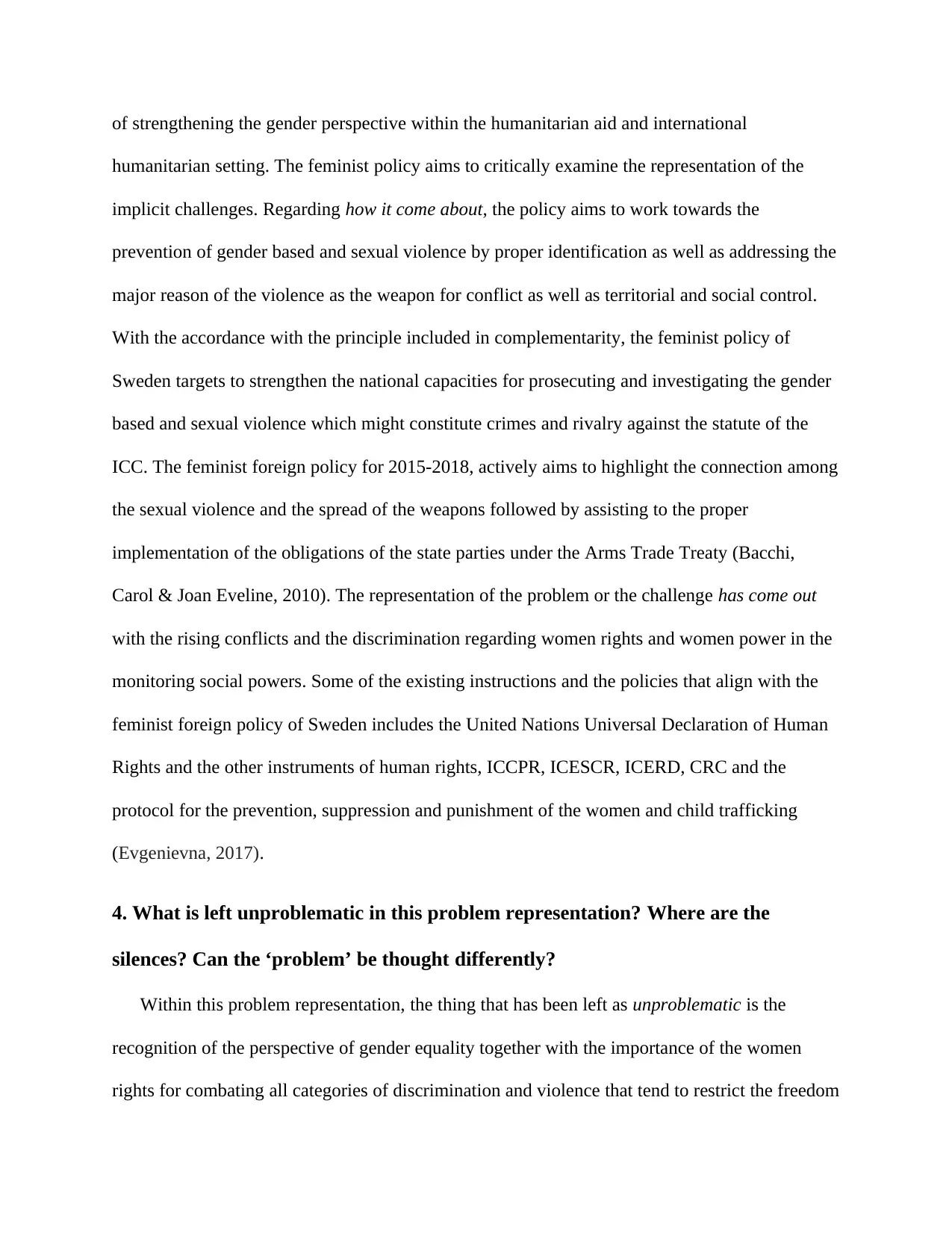
of strengthening the gender perspective within the humanitarian aid and international
humanitarian setting. The feminist policy aims to critically examine the representation of the
implicit challenges. Regarding how it come about, the policy aims to work towards the
prevention of gender based and sexual violence by proper identification as well as addressing the
major reason of the violence as the weapon for conflict as well as territorial and social control.
With the accordance with the principle included in complementarity, the feminist policy of
Sweden targets to strengthen the national capacities for prosecuting and investigating the gender
based and sexual violence which might constitute crimes and rivalry against the statute of the
ICC. The feminist foreign policy for 2015-2018, actively aims to highlight the connection among
the sexual violence and the spread of the weapons followed by assisting to the proper
implementation of the obligations of the state parties under the Arms Trade Treaty (Bacchi,
Carol & Joan Eveline, 2010). The representation of the problem or the challenge has come out
with the rising conflicts and the discrimination regarding women rights and women power in the
monitoring social powers. Some of the existing instructions and the policies that align with the
feminist foreign policy of Sweden includes the United Nations Universal Declaration of Human
Rights and the other instruments of human rights, ICCPR, ICESCR, ICERD, CRC and the
protocol for the prevention, suppression and punishment of the women and child trafficking
(Evgenievna, 2017).
4. What is left unproblematic in this problem representation? Where are the
silences? Can the ‘problem’ be thought differently?
Within this problem representation, the thing that has been left as unproblematic is the
recognition of the perspective of gender equality together with the importance of the women
rights for combating all categories of discrimination and violence that tend to restrict the freedom
humanitarian setting. The feminist policy aims to critically examine the representation of the
implicit challenges. Regarding how it come about, the policy aims to work towards the
prevention of gender based and sexual violence by proper identification as well as addressing the
major reason of the violence as the weapon for conflict as well as territorial and social control.
With the accordance with the principle included in complementarity, the feminist policy of
Sweden targets to strengthen the national capacities for prosecuting and investigating the gender
based and sexual violence which might constitute crimes and rivalry against the statute of the
ICC. The feminist foreign policy for 2015-2018, actively aims to highlight the connection among
the sexual violence and the spread of the weapons followed by assisting to the proper
implementation of the obligations of the state parties under the Arms Trade Treaty (Bacchi,
Carol & Joan Eveline, 2010). The representation of the problem or the challenge has come out
with the rising conflicts and the discrimination regarding women rights and women power in the
monitoring social powers. Some of the existing instructions and the policies that align with the
feminist foreign policy of Sweden includes the United Nations Universal Declaration of Human
Rights and the other instruments of human rights, ICCPR, ICESCR, ICERD, CRC and the
protocol for the prevention, suppression and punishment of the women and child trafficking
(Evgenievna, 2017).
4. What is left unproblematic in this problem representation? Where are the
silences? Can the ‘problem’ be thought differently?
Within this problem representation, the thing that has been left as unproblematic is the
recognition of the perspective of gender equality together with the importance of the women
rights for combating all categories of discrimination and violence that tend to restrict the freedom
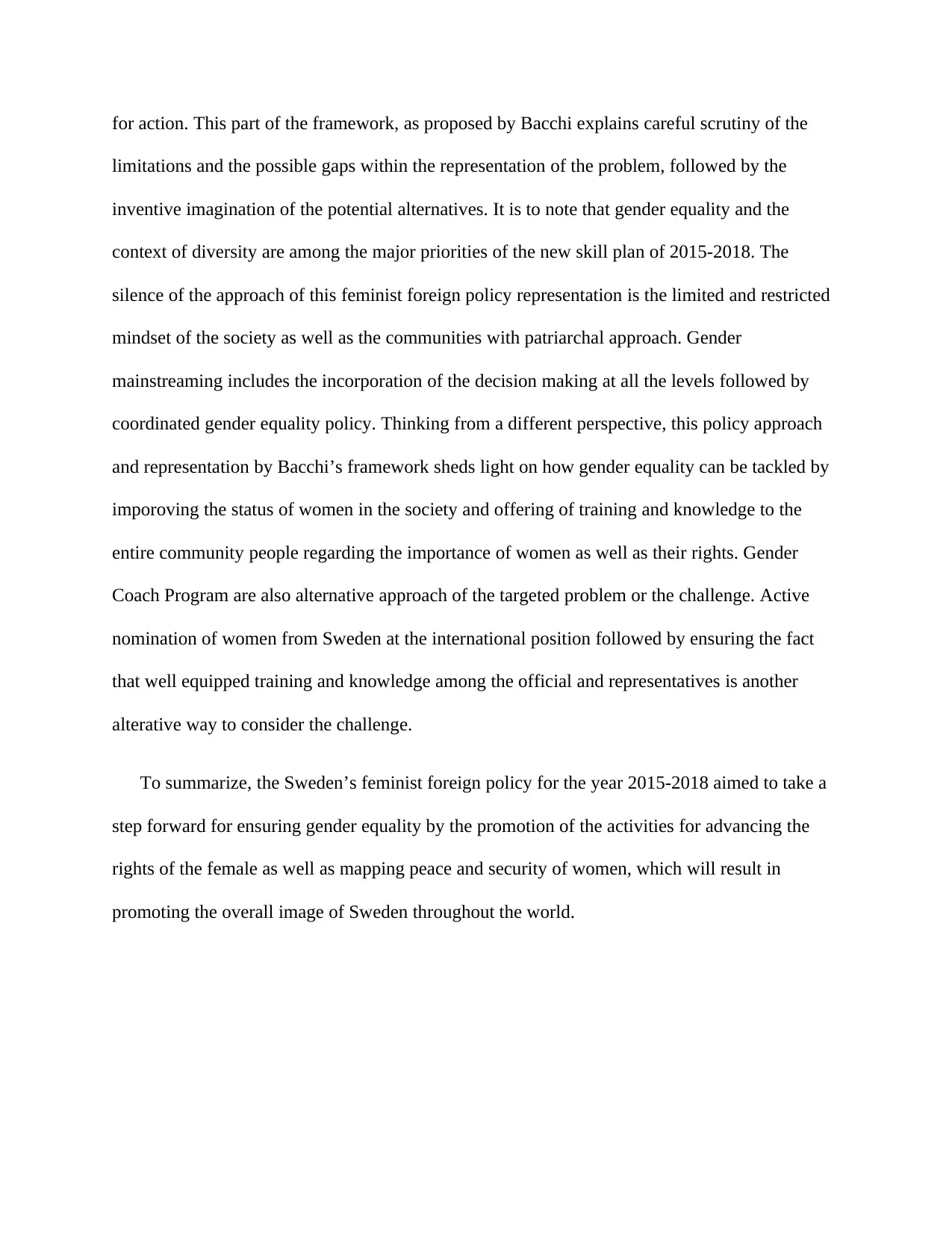
for action. This part of the framework, as proposed by Bacchi explains careful scrutiny of the
limitations and the possible gaps within the representation of the problem, followed by the
inventive imagination of the potential alternatives. It is to note that gender equality and the
context of diversity are among the major priorities of the new skill plan of 2015-2018. The
silence of the approach of this feminist foreign policy representation is the limited and restricted
mindset of the society as well as the communities with patriarchal approach. Gender
mainstreaming includes the incorporation of the decision making at all the levels followed by
coordinated gender equality policy. Thinking from a different perspective, this policy approach
and representation by Bacchi’s framework sheds light on how gender equality can be tackled by
imporoving the status of women in the society and offering of training and knowledge to the
entire community people regarding the importance of women as well as their rights. Gender
Coach Program are also alternative approach of the targeted problem or the challenge. Active
nomination of women from Sweden at the international position followed by ensuring the fact
that well equipped training and knowledge among the official and representatives is another
alterative way to consider the challenge.
To summarize, the Sweden’s feminist foreign policy for the year 2015-2018 aimed to take a
step forward for ensuring gender equality by the promotion of the activities for advancing the
rights of the female as well as mapping peace and security of women, which will result in
promoting the overall image of Sweden throughout the world.
limitations and the possible gaps within the representation of the problem, followed by the
inventive imagination of the potential alternatives. It is to note that gender equality and the
context of diversity are among the major priorities of the new skill plan of 2015-2018. The
silence of the approach of this feminist foreign policy representation is the limited and restricted
mindset of the society as well as the communities with patriarchal approach. Gender
mainstreaming includes the incorporation of the decision making at all the levels followed by
coordinated gender equality policy. Thinking from a different perspective, this policy approach
and representation by Bacchi’s framework sheds light on how gender equality can be tackled by
imporoving the status of women in the society and offering of training and knowledge to the
entire community people regarding the importance of women as well as their rights. Gender
Coach Program are also alternative approach of the targeted problem or the challenge. Active
nomination of women from Sweden at the international position followed by ensuring the fact
that well equipped training and knowledge among the official and representatives is another
alterative way to consider the challenge.
To summarize, the Sweden’s feminist foreign policy for the year 2015-2018 aimed to take a
step forward for ensuring gender equality by the promotion of the activities for advancing the
rights of the female as well as mapping peace and security of women, which will result in
promoting the overall image of Sweden throughout the world.
⊘ This is a preview!⊘
Do you want full access?
Subscribe today to unlock all pages.

Trusted by 1+ million students worldwide
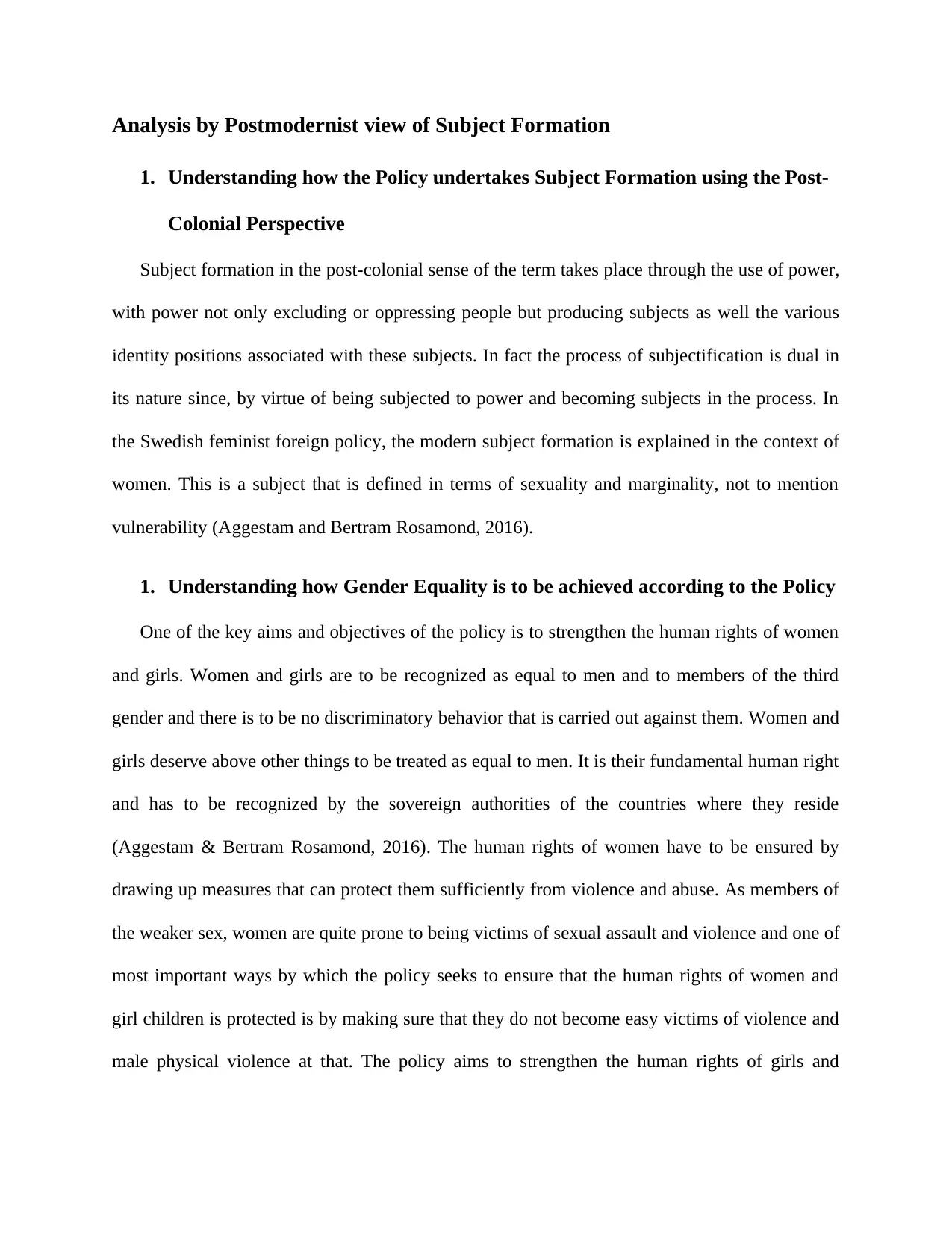
Analysis by Postmodernist view of Subject Formation
1. Understanding how the Policy undertakes Subject Formation using the Post-
Colonial Perspective
Subject formation in the post-colonial sense of the term takes place through the use of power,
with power not only excluding or oppressing people but producing subjects as well the various
identity positions associated with these subjects. In fact the process of subjectification is dual in
its nature since, by virtue of being subjected to power and becoming subjects in the process. In
the Swedish feminist foreign policy, the modern subject formation is explained in the context of
women. This is a subject that is defined in terms of sexuality and marginality, not to mention
vulnerability (Aggestam and Bertram Rosamond, 2016).
1. Understanding how Gender Equality is to be achieved according to the Policy
One of the key aims and objectives of the policy is to strengthen the human rights of women
and girls. Women and girls are to be recognized as equal to men and to members of the third
gender and there is to be no discriminatory behavior that is carried out against them. Women and
girls deserve above other things to be treated as equal to men. It is their fundamental human right
and has to be recognized by the sovereign authorities of the countries where they reside
(Aggestam & Bertram Rosamond, 2016). The human rights of women have to be ensured by
drawing up measures that can protect them sufficiently from violence and abuse. As members of
the weaker sex, women are quite prone to being victims of sexual assault and violence and one of
most important ways by which the policy seeks to ensure that the human rights of women and
girl children is protected is by making sure that they do not become easy victims of violence and
male physical violence at that. The policy aims to strengthen the human rights of girls and
1. Understanding how the Policy undertakes Subject Formation using the Post-
Colonial Perspective
Subject formation in the post-colonial sense of the term takes place through the use of power,
with power not only excluding or oppressing people but producing subjects as well the various
identity positions associated with these subjects. In fact the process of subjectification is dual in
its nature since, by virtue of being subjected to power and becoming subjects in the process. In
the Swedish feminist foreign policy, the modern subject formation is explained in the context of
women. This is a subject that is defined in terms of sexuality and marginality, not to mention
vulnerability (Aggestam and Bertram Rosamond, 2016).
1. Understanding how Gender Equality is to be achieved according to the Policy
One of the key aims and objectives of the policy is to strengthen the human rights of women
and girls. Women and girls are to be recognized as equal to men and to members of the third
gender and there is to be no discriminatory behavior that is carried out against them. Women and
girls deserve above other things to be treated as equal to men. It is their fundamental human right
and has to be recognized by the sovereign authorities of the countries where they reside
(Aggestam & Bertram Rosamond, 2016). The human rights of women have to be ensured by
drawing up measures that can protect them sufficiently from violence and abuse. As members of
the weaker sex, women are quite prone to being victims of sexual assault and violence and one of
most important ways by which the policy seeks to ensure that the human rights of women and
girl children is protected is by making sure that they do not become easy victims of violence and
male physical violence at that. The policy aims to strengthen the human rights of girls and
Paraphrase This Document
Need a fresh take? Get an instant paraphrase of this document with our AI Paraphraser
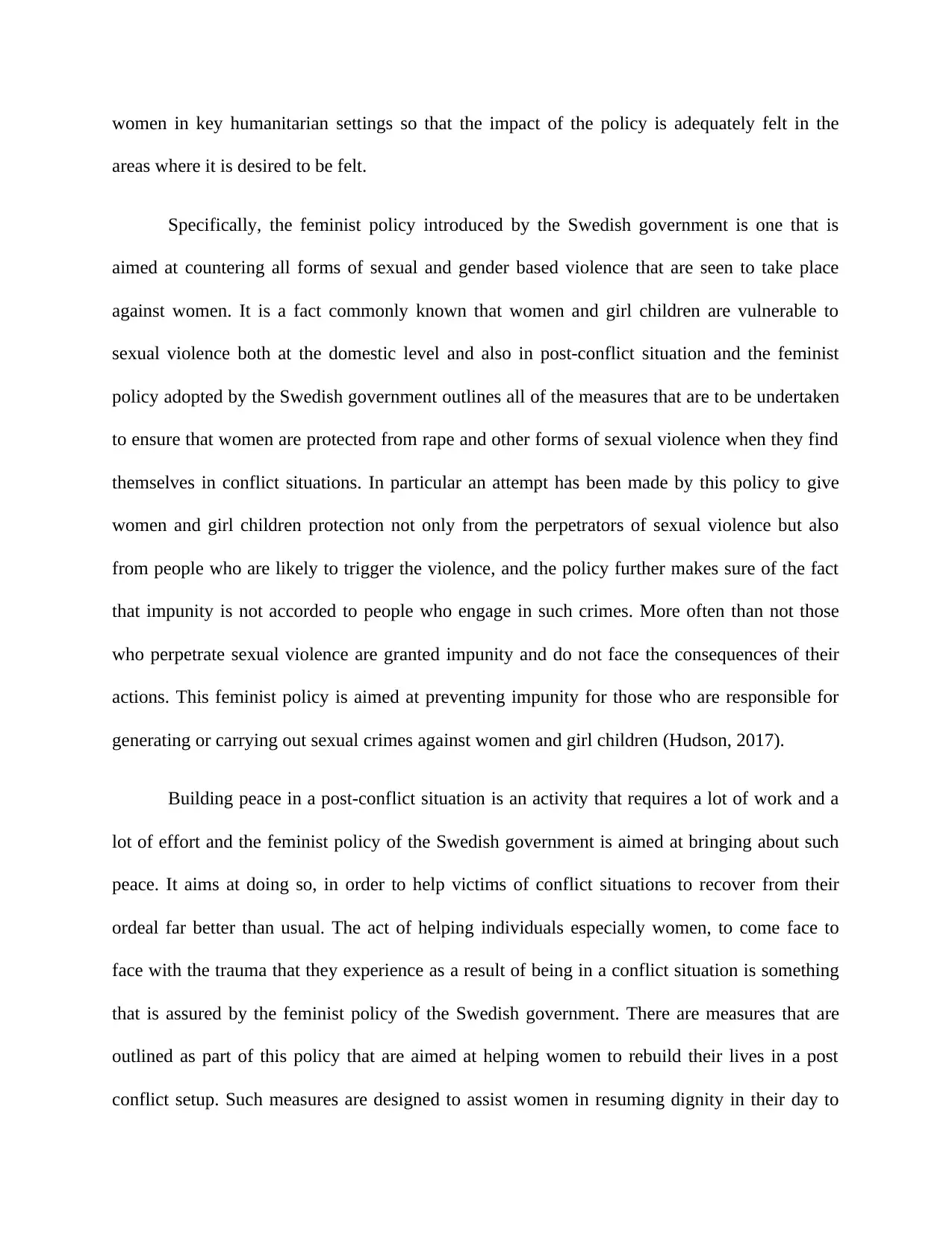
women in key humanitarian settings so that the impact of the policy is adequately felt in the
areas where it is desired to be felt.
Specifically, the feminist policy introduced by the Swedish government is one that is
aimed at countering all forms of sexual and gender based violence that are seen to take place
against women. It is a fact commonly known that women and girl children are vulnerable to
sexual violence both at the domestic level and also in post-conflict situation and the feminist
policy adopted by the Swedish government outlines all of the measures that are to be undertaken
to ensure that women are protected from rape and other forms of sexual violence when they find
themselves in conflict situations. In particular an attempt has been made by this policy to give
women and girl children protection not only from the perpetrators of sexual violence but also
from people who are likely to trigger the violence, and the policy further makes sure of the fact
that impunity is not accorded to people who engage in such crimes. More often than not those
who perpetrate sexual violence are granted impunity and do not face the consequences of their
actions. This feminist policy is aimed at preventing impunity for those who are responsible for
generating or carrying out sexual crimes against women and girl children (Hudson, 2017).
Building peace in a post-conflict situation is an activity that requires a lot of work and a
lot of effort and the feminist policy of the Swedish government is aimed at bringing about such
peace. It aims at doing so, in order to help victims of conflict situations to recover from their
ordeal far better than usual. The act of helping individuals especially women, to come face to
face with the trauma that they experience as a result of being in a conflict situation is something
that is assured by the feminist policy of the Swedish government. There are measures that are
outlined as part of this policy that are aimed at helping women to rebuild their lives in a post
conflict setup. Such measures are designed to assist women in resuming dignity in their day to
areas where it is desired to be felt.
Specifically, the feminist policy introduced by the Swedish government is one that is
aimed at countering all forms of sexual and gender based violence that are seen to take place
against women. It is a fact commonly known that women and girl children are vulnerable to
sexual violence both at the domestic level and also in post-conflict situation and the feminist
policy adopted by the Swedish government outlines all of the measures that are to be undertaken
to ensure that women are protected from rape and other forms of sexual violence when they find
themselves in conflict situations. In particular an attempt has been made by this policy to give
women and girl children protection not only from the perpetrators of sexual violence but also
from people who are likely to trigger the violence, and the policy further makes sure of the fact
that impunity is not accorded to people who engage in such crimes. More often than not those
who perpetrate sexual violence are granted impunity and do not face the consequences of their
actions. This feminist policy is aimed at preventing impunity for those who are responsible for
generating or carrying out sexual crimes against women and girl children (Hudson, 2017).
Building peace in a post-conflict situation is an activity that requires a lot of work and a
lot of effort and the feminist policy of the Swedish government is aimed at bringing about such
peace. It aims at doing so, in order to help victims of conflict situations to recover from their
ordeal far better than usual. The act of helping individuals especially women, to come face to
face with the trauma that they experience as a result of being in a conflict situation is something
that is assured by the feminist policy of the Swedish government. There are measures that are
outlined as part of this policy that are aimed at helping women to rebuild their lives in a post
conflict setup. Such measures are designed to assist women in resuming dignity in their day to
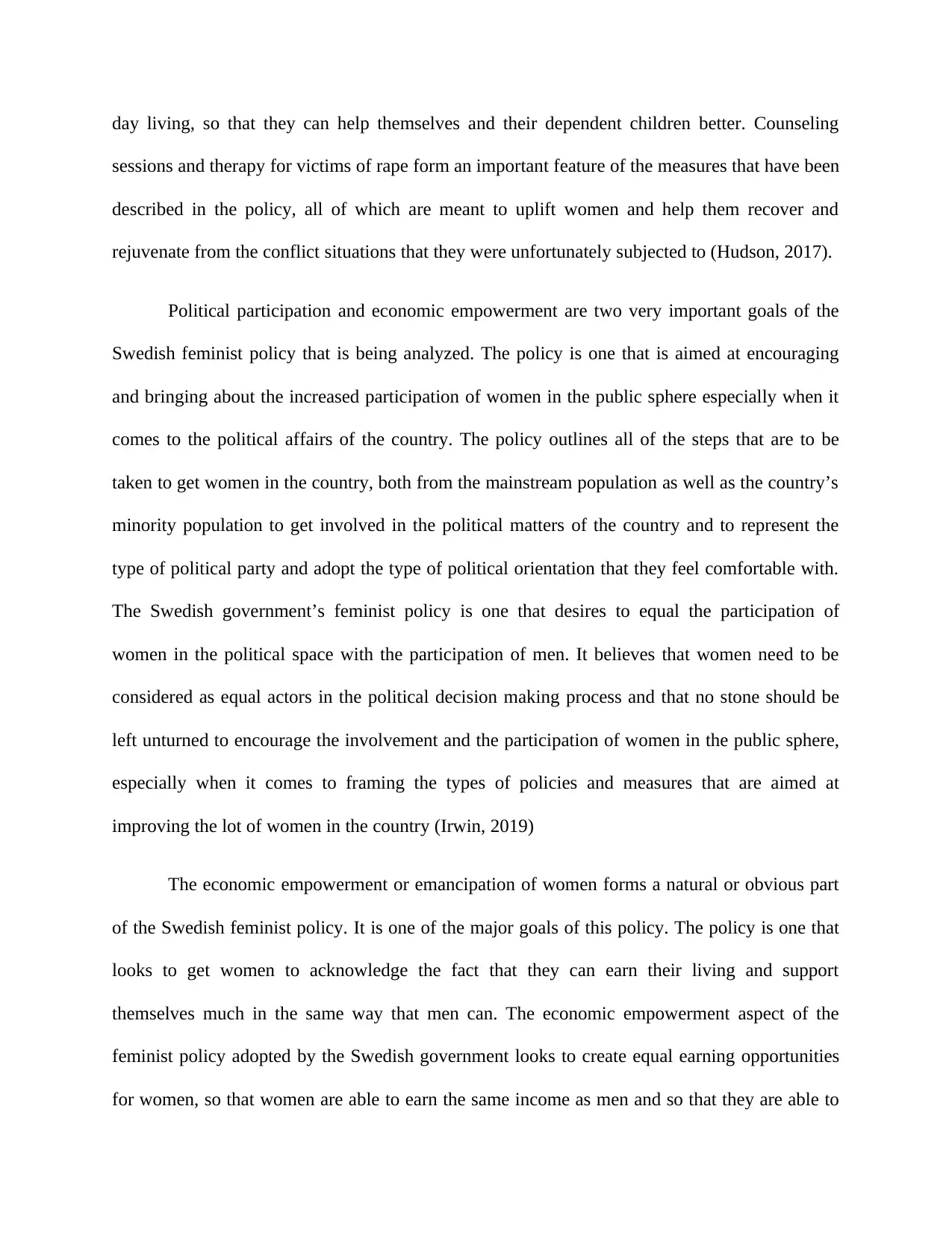
day living, so that they can help themselves and their dependent children better. Counseling
sessions and therapy for victims of rape form an important feature of the measures that have been
described in the policy, all of which are meant to uplift women and help them recover and
rejuvenate from the conflict situations that they were unfortunately subjected to (Hudson, 2017).
Political participation and economic empowerment are two very important goals of the
Swedish feminist policy that is being analyzed. The policy is one that is aimed at encouraging
and bringing about the increased participation of women in the public sphere especially when it
comes to the political affairs of the country. The policy outlines all of the steps that are to be
taken to get women in the country, both from the mainstream population as well as the country’s
minority population to get involved in the political matters of the country and to represent the
type of political party and adopt the type of political orientation that they feel comfortable with.
The Swedish government’s feminist policy is one that desires to equal the participation of
women in the political space with the participation of men. It believes that women need to be
considered as equal actors in the political decision making process and that no stone should be
left unturned to encourage the involvement and the participation of women in the public sphere,
especially when it comes to framing the types of policies and measures that are aimed at
improving the lot of women in the country (Irwin, 2019)
The economic empowerment or emancipation of women forms a natural or obvious part
of the Swedish feminist policy. It is one of the major goals of this policy. The policy is one that
looks to get women to acknowledge the fact that they can earn their living and support
themselves much in the same way that men can. The economic empowerment aspect of the
feminist policy adopted by the Swedish government looks to create equal earning opportunities
for women, so that women are able to earn the same income as men and so that they are able to
sessions and therapy for victims of rape form an important feature of the measures that have been
described in the policy, all of which are meant to uplift women and help them recover and
rejuvenate from the conflict situations that they were unfortunately subjected to (Hudson, 2017).
Political participation and economic empowerment are two very important goals of the
Swedish feminist policy that is being analyzed. The policy is one that is aimed at encouraging
and bringing about the increased participation of women in the public sphere especially when it
comes to the political affairs of the country. The policy outlines all of the steps that are to be
taken to get women in the country, both from the mainstream population as well as the country’s
minority population to get involved in the political matters of the country and to represent the
type of political party and adopt the type of political orientation that they feel comfortable with.
The Swedish government’s feminist policy is one that desires to equal the participation of
women in the political space with the participation of men. It believes that women need to be
considered as equal actors in the political decision making process and that no stone should be
left unturned to encourage the involvement and the participation of women in the public sphere,
especially when it comes to framing the types of policies and measures that are aimed at
improving the lot of women in the country (Irwin, 2019)
The economic empowerment or emancipation of women forms a natural or obvious part
of the Swedish feminist policy. It is one of the major goals of this policy. The policy is one that
looks to get women to acknowledge the fact that they can earn their living and support
themselves much in the same way that men can. The economic empowerment aspect of the
feminist policy adopted by the Swedish government looks to create equal earning opportunities
for women, so that women are able to earn the same income as men and so that they are able to
⊘ This is a preview!⊘
Do you want full access?
Subscribe today to unlock all pages.

Trusted by 1+ million students worldwide
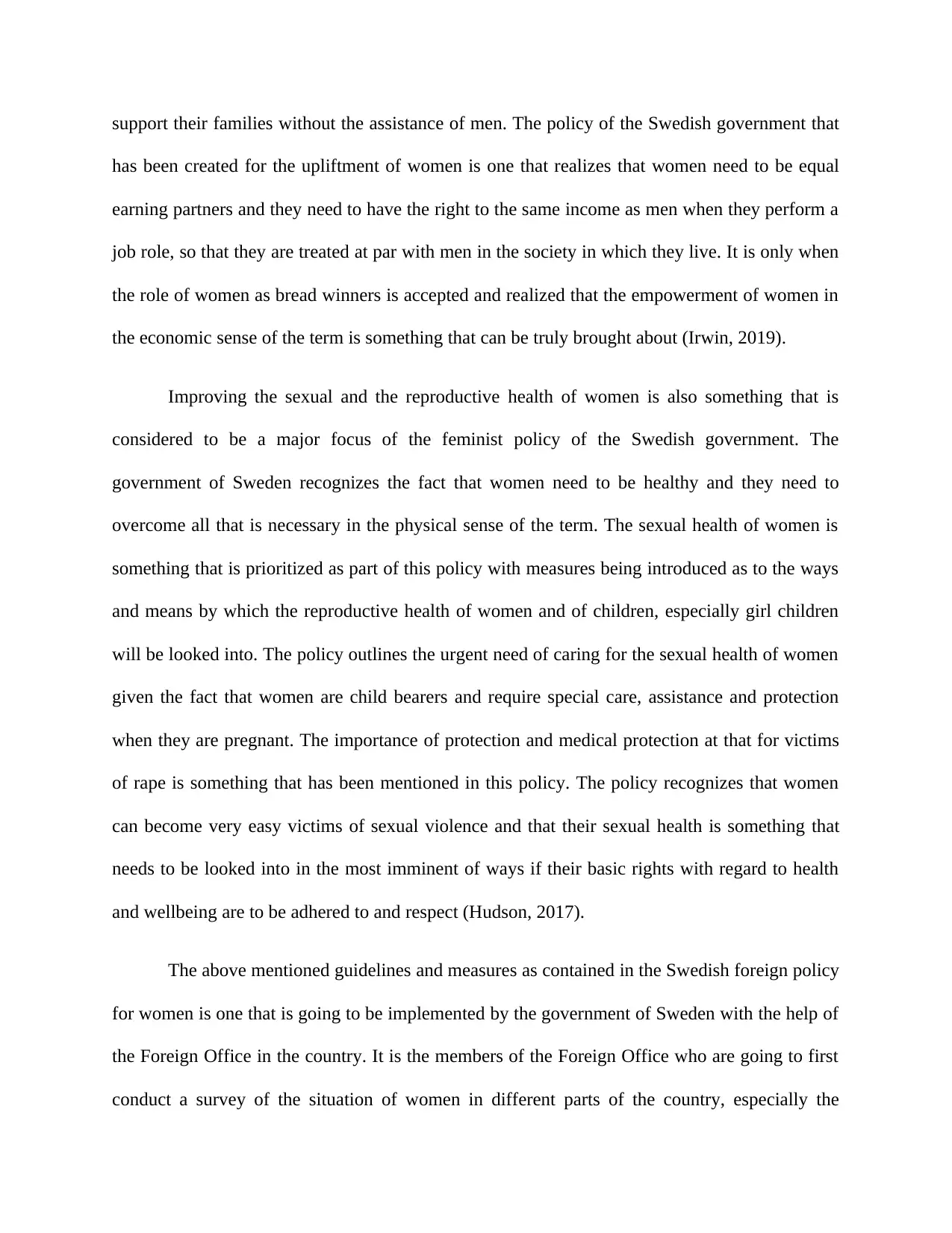
support their families without the assistance of men. The policy of the Swedish government that
has been created for the upliftment of women is one that realizes that women need to be equal
earning partners and they need to have the right to the same income as men when they perform a
job role, so that they are treated at par with men in the society in which they live. It is only when
the role of women as bread winners is accepted and realized that the empowerment of women in
the economic sense of the term is something that can be truly brought about (Irwin, 2019).
Improving the sexual and the reproductive health of women is also something that is
considered to be a major focus of the feminist policy of the Swedish government. The
government of Sweden recognizes the fact that women need to be healthy and they need to
overcome all that is necessary in the physical sense of the term. The sexual health of women is
something that is prioritized as part of this policy with measures being introduced as to the ways
and means by which the reproductive health of women and of children, especially girl children
will be looked into. The policy outlines the urgent need of caring for the sexual health of women
given the fact that women are child bearers and require special care, assistance and protection
when they are pregnant. The importance of protection and medical protection at that for victims
of rape is something that has been mentioned in this policy. The policy recognizes that women
can become very easy victims of sexual violence and that their sexual health is something that
needs to be looked into in the most imminent of ways if their basic rights with regard to health
and wellbeing are to be adhered to and respect (Hudson, 2017).
The above mentioned guidelines and measures as contained in the Swedish foreign policy
for women is one that is going to be implemented by the government of Sweden with the help of
the Foreign Office in the country. It is the members of the Foreign Office who are going to first
conduct a survey of the situation of women in different parts of the country, especially the
has been created for the upliftment of women is one that realizes that women need to be equal
earning partners and they need to have the right to the same income as men when they perform a
job role, so that they are treated at par with men in the society in which they live. It is only when
the role of women as bread winners is accepted and realized that the empowerment of women in
the economic sense of the term is something that can be truly brought about (Irwin, 2019).
Improving the sexual and the reproductive health of women is also something that is
considered to be a major focus of the feminist policy of the Swedish government. The
government of Sweden recognizes the fact that women need to be healthy and they need to
overcome all that is necessary in the physical sense of the term. The sexual health of women is
something that is prioritized as part of this policy with measures being introduced as to the ways
and means by which the reproductive health of women and of children, especially girl children
will be looked into. The policy outlines the urgent need of caring for the sexual health of women
given the fact that women are child bearers and require special care, assistance and protection
when they are pregnant. The importance of protection and medical protection at that for victims
of rape is something that has been mentioned in this policy. The policy recognizes that women
can become very easy victims of sexual violence and that their sexual health is something that
needs to be looked into in the most imminent of ways if their basic rights with regard to health
and wellbeing are to be adhered to and respect (Hudson, 2017).
The above mentioned guidelines and measures as contained in the Swedish foreign policy
for women is one that is going to be implemented by the government of Sweden with the help of
the Foreign Office in the country. It is the members of the Foreign Office who are going to first
conduct a survey of the situation of women in different parts of the country, especially the
Paraphrase This Document
Need a fresh take? Get an instant paraphrase of this document with our AI Paraphraser
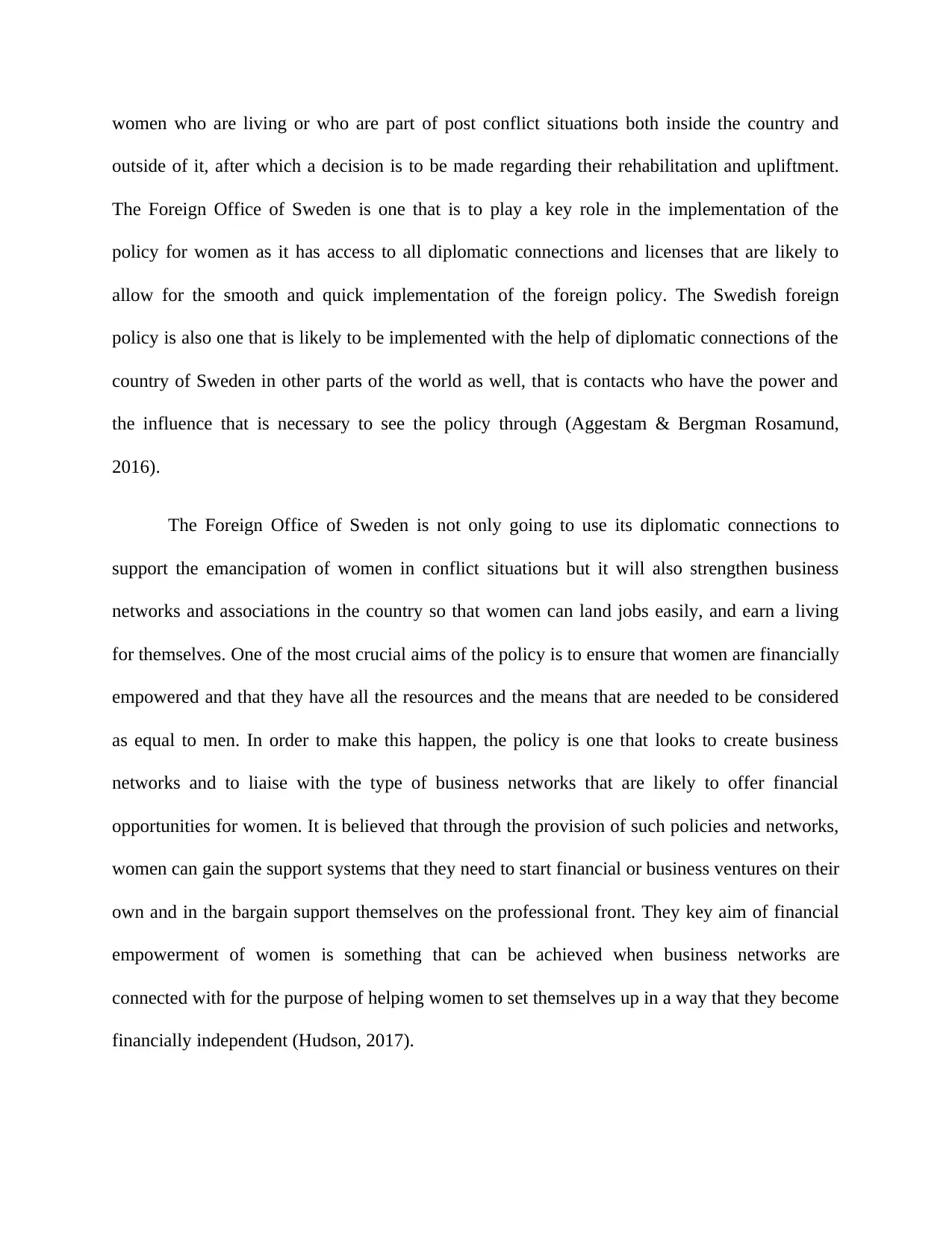
women who are living or who are part of post conflict situations both inside the country and
outside of it, after which a decision is to be made regarding their rehabilitation and upliftment.
The Foreign Office of Sweden is one that is to play a key role in the implementation of the
policy for women as it has access to all diplomatic connections and licenses that are likely to
allow for the smooth and quick implementation of the foreign policy. The Swedish foreign
policy is also one that is likely to be implemented with the help of diplomatic connections of the
country of Sweden in other parts of the world as well, that is contacts who have the power and
the influence that is necessary to see the policy through (Aggestam & Bergman Rosamund,
2016).
The Foreign Office of Sweden is not only going to use its diplomatic connections to
support the emancipation of women in conflict situations but it will also strengthen business
networks and associations in the country so that women can land jobs easily, and earn a living
for themselves. One of the most crucial aims of the policy is to ensure that women are financially
empowered and that they have all the resources and the means that are needed to be considered
as equal to men. In order to make this happen, the policy is one that looks to create business
networks and to liaise with the type of business networks that are likely to offer financial
opportunities for women. It is believed that through the provision of such policies and networks,
women can gain the support systems that they need to start financial or business ventures on their
own and in the bargain support themselves on the professional front. They key aim of financial
empowerment of women is something that can be achieved when business networks are
connected with for the purpose of helping women to set themselves up in a way that they become
financially independent (Hudson, 2017).
outside of it, after which a decision is to be made regarding their rehabilitation and upliftment.
The Foreign Office of Sweden is one that is to play a key role in the implementation of the
policy for women as it has access to all diplomatic connections and licenses that are likely to
allow for the smooth and quick implementation of the foreign policy. The Swedish foreign
policy is also one that is likely to be implemented with the help of diplomatic connections of the
country of Sweden in other parts of the world as well, that is contacts who have the power and
the influence that is necessary to see the policy through (Aggestam & Bergman Rosamund,
2016).
The Foreign Office of Sweden is not only going to use its diplomatic connections to
support the emancipation of women in conflict situations but it will also strengthen business
networks and associations in the country so that women can land jobs easily, and earn a living
for themselves. One of the most crucial aims of the policy is to ensure that women are financially
empowered and that they have all the resources and the means that are needed to be considered
as equal to men. In order to make this happen, the policy is one that looks to create business
networks and to liaise with the type of business networks that are likely to offer financial
opportunities for women. It is believed that through the provision of such policies and networks,
women can gain the support systems that they need to start financial or business ventures on their
own and in the bargain support themselves on the professional front. They key aim of financial
empowerment of women is something that can be achieved when business networks are
connected with for the purpose of helping women to set themselves up in a way that they become
financially independent (Hudson, 2017).
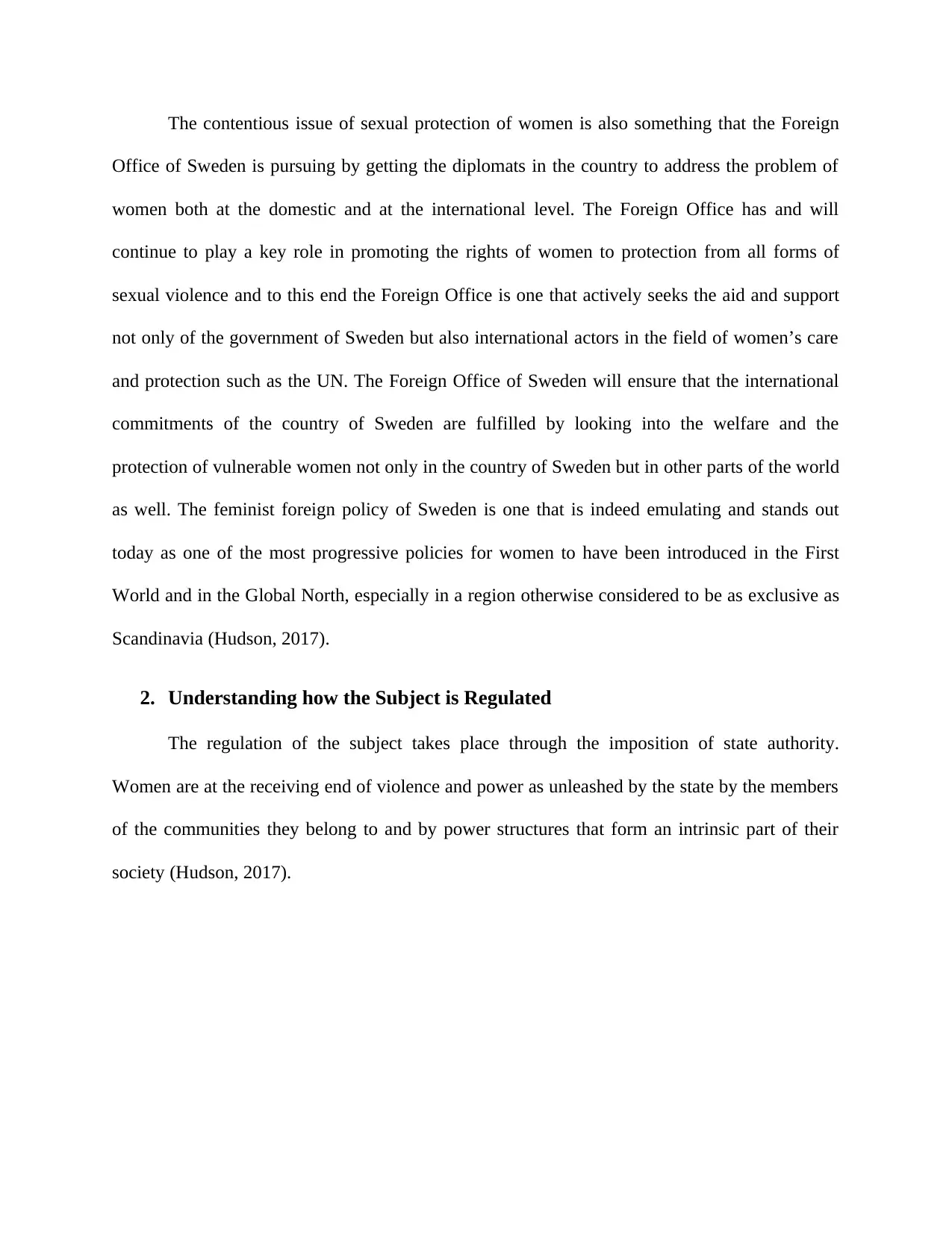
The contentious issue of sexual protection of women is also something that the Foreign
Office of Sweden is pursuing by getting the diplomats in the country to address the problem of
women both at the domestic and at the international level. The Foreign Office has and will
continue to play a key role in promoting the rights of women to protection from all forms of
sexual violence and to this end the Foreign Office is one that actively seeks the aid and support
not only of the government of Sweden but also international actors in the field of women’s care
and protection such as the UN. The Foreign Office of Sweden will ensure that the international
commitments of the country of Sweden are fulfilled by looking into the welfare and the
protection of vulnerable women not only in the country of Sweden but in other parts of the world
as well. The feminist foreign policy of Sweden is one that is indeed emulating and stands out
today as one of the most progressive policies for women to have been introduced in the First
World and in the Global North, especially in a region otherwise considered to be as exclusive as
Scandinavia (Hudson, 2017).
2. Understanding how the Subject is Regulated
The regulation of the subject takes place through the imposition of state authority.
Women are at the receiving end of violence and power as unleashed by the state by the members
of the communities they belong to and by power structures that form an intrinsic part of their
society (Hudson, 2017).
Office of Sweden is pursuing by getting the diplomats in the country to address the problem of
women both at the domestic and at the international level. The Foreign Office has and will
continue to play a key role in promoting the rights of women to protection from all forms of
sexual violence and to this end the Foreign Office is one that actively seeks the aid and support
not only of the government of Sweden but also international actors in the field of women’s care
and protection such as the UN. The Foreign Office of Sweden will ensure that the international
commitments of the country of Sweden are fulfilled by looking into the welfare and the
protection of vulnerable women not only in the country of Sweden but in other parts of the world
as well. The feminist foreign policy of Sweden is one that is indeed emulating and stands out
today as one of the most progressive policies for women to have been introduced in the First
World and in the Global North, especially in a region otherwise considered to be as exclusive as
Scandinavia (Hudson, 2017).
2. Understanding how the Subject is Regulated
The regulation of the subject takes place through the imposition of state authority.
Women are at the receiving end of violence and power as unleashed by the state by the members
of the communities they belong to and by power structures that form an intrinsic part of their
society (Hudson, 2017).
⊘ This is a preview!⊘
Do you want full access?
Subscribe today to unlock all pages.

Trusted by 1+ million students worldwide
1 out of 15
Your All-in-One AI-Powered Toolkit for Academic Success.
+13062052269
info@desklib.com
Available 24*7 on WhatsApp / Email
![[object Object]](/_next/static/media/star-bottom.7253800d.svg)
Unlock your academic potential
Copyright © 2020–2025 A2Z Services. All Rights Reserved. Developed and managed by ZUCOL.
